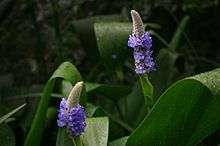Pontederia
| Pontederia | |
|---|---|
| | |
| Pontederia cordata | |
| Scientific classification | |
| Kingdom: | Plantae |
| (unranked): | Angiosperms |
| (unranked): | Monocots |
| (unranked): | Commelinids |
| Order: | Commelinales |
| Family: | Pontederiaceae |
| Genus: | Pontederia L. |
| Species | |
|
See text. | |
Pontederia is a genus of tristylous aquatic plants, members of which are commonly known as pickerel weeds. Pontederia is endemic to the Americas, distributed from Canada to Argentina, where it is found in shallow water or on mud. The genus was named by Linnaeus in honour of the Italian botanist Giulio Pontedera.
Pontederia plants have large waxy leaves, succulent stems and a thick pad of fibrous roots. The roots give rise to rhizomes that allow rapid colonization by vegetative reproduction. Species are perennial, and produce a large spike of flowers in the summer. There is a species of bee (Dufourea novaeangliae) that exclusively visits Pontederia cordata; waterfowl also eat the fruit of the plant.
Pontederia cordata, and another member of the family, Eichhornia crassipes, have become invasive in many tropical and temperate parts of the globe, but are, on the other hand, efficient biological filters of polluted water in constructed wetlands.[1]
Species
- Pontederia cordata L.
- Pontederia parviflora Alexander
- Pontederia rotundifolia L.f.
- Pontederia sagittata C.Presl
- Pontederia subovata (Seub.) Lowden
- Pontederia triflora (Endl. ex Seub.) G.Agostini, D.Velázquez & J.Velásquez
References
- ↑ Kadlec, Robert H.; Scott Wallace (2008). Treatment Wetlands (2 ed.). CRC Press. p. 97. ISBN 978-1-56670-526-4.
External links
| Wikimedia Commons has media related to Pontederia. |
| Wikispecies has information related to: Pontederia |

